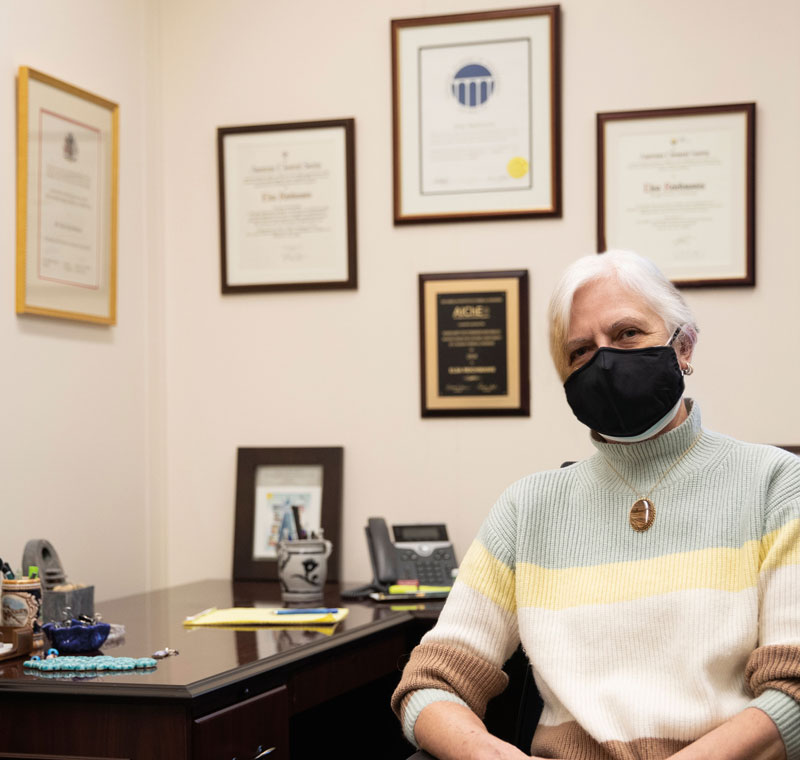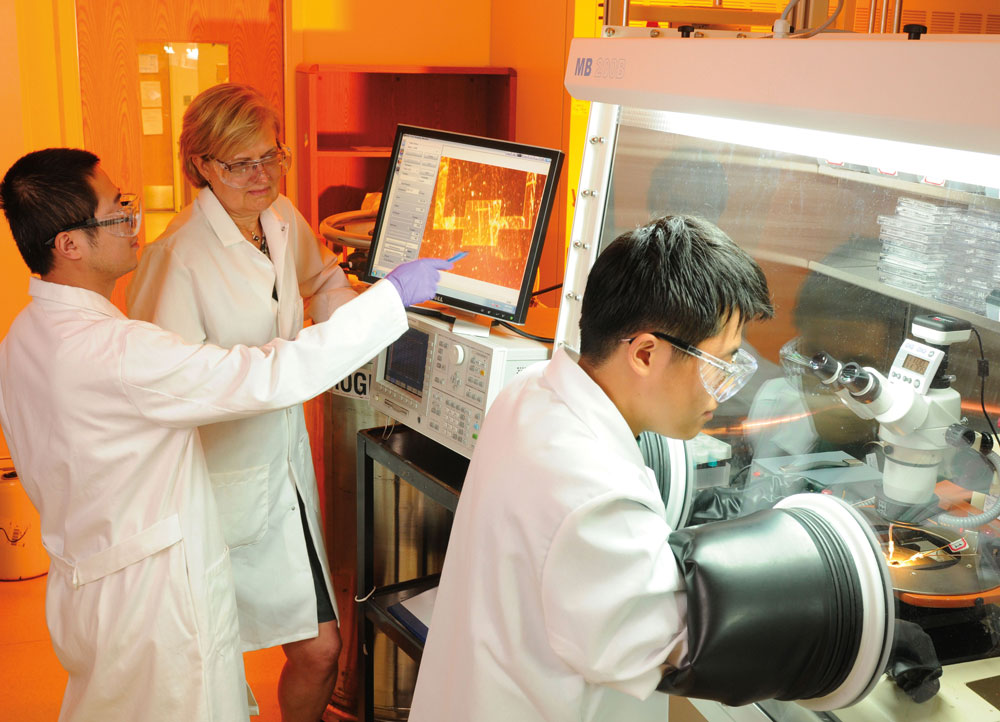Interview by Katie Kackenmeister
World-renowned polymer chemist Elsa Reichmanis joined the Rossin College in 2020 as Professor and Carl Robert Anderson Chair in Chemical Engineering, following 12 years at the Georgia Institute of Technology. Prior to entering academia, Reichmanis was a researcher at AT&T Bell Laboratories, where she played a foundational role in microlithography, a field central to the manufacturing of electronic devices. Over almost three decades at Bell Labs, she contributed to 20-plus U.S. patents for innovations that helped drive the personal computer revolution. Today, her research at the interface of chemical engineering, chemistry, and materials science continues to draw accolades. Reichmanis is a member of the National Academy of Engineering and was recently elected as both a Fellow of the American Institute of Chemical Engineers and the National Academy of Inventors.
|
Elsa Reichmanis joined Lehigh as Professor and Carl Robert Anderson Chair in Chemical Engineering in 2020. (Photo Credit: By Stephanie Veto/Lehigh University) |
Q: What is microlithography and how has your work advanced the field?
A: Microlithography uses “resist materials” to define the circuit patterns on the silicon memory chips that drive computers and cell phones—and just about every electronic device. It’s a process with roots in traditional lithography, where you might scrape a pattern with a knife into a stone surface, cover it with grease, and then transfer that pattern to a piece of paper or parchment. Microlithography is very similar but on a much finer scale. Related processes can be used in broader photonic devices, optoelectronic devices, and the large communication switches that enable internet communications.
The challenge with silicon has been that the feature size—sort of like the wiring—has continually become smaller. When I started at Bell Labs, there was interest in using shorter wavelengths of light to pattern these features, which would enable much higher resolution. So we looked at different chemistries for photopolymers that could be coated on the silicon substrate, essentially developing the “grease” that would allow us to create, on a nanometer scale, a wiring diagram for a silicon circuit.
My contribution was investigating the photochemistry—identifying approaches to developing polymer materials that respond to light and defining the requirements needed in a photopolymer, or resist, to achieve the desired performance.
Q: How has microlithography influenced the development of modern electronics?
A: We certainly take cell phones and laptops for granted. Even email and social networking rely on the circuitry in our electronics. And those devices didn’t come about just because one person had an aha moment. It took many people with varying expertise addressing different pieces of the puzzle. The silicon circuit memory device in your phone or computer today has probably more than 30 different layers of materials. All of them need to be deposited and patterned with precision. To make these chips work and continually improve the technology requires many different disciplines coming together, communicating, and learning from each other.
Q: Was that your experience working at Bell Labs?
A: The environment was interactive, and everybody’s door was open. We were all together, not in separate buildings, and if you had a question, you’d just find the expert to go ask. We frequently got together for lunch or morning coffee, just to chat. Someone would throw out a question or an idea, and those conversations led to chemists working with physicists working with electrical engineers, and so on.
|
(Photo Credit: Rob Felt/Georgia Institute of Technology) |
Q: So the breakthroughs of that time were driven by interdisciplinary collaboration?
A: That’s exactly what the development of technology requires. With diversity of perspectives and a variety of expertise, you can create something new that can benefit the world. I joined Bell Labs when I was just a kid, and this was the environment that I grew up in. And in the short time I’ve been at Lehigh, I’ve become involved in a few proposals, and I’m already seeing the interactive culture that exists here. Collaboration is seen as a good thing, and that will allow our research to have a positive impact on society.
Q: What research problems are you currently investigating?
A: I’m exploring large-scale processes that can be made more cost-effective and sustainable. Can we use less material and waste less? Can we go into additive manufacturing processes? To do that, we need better understanding of the role surfaces play and how we can manipulate their characteristics to improve their properties from an electronic or optical perspective that could be useful in a device.
I’m also interested in whether we can manipulate surface chemistries so they behave in a more biocompatible way. Could a combination of electrical transport and ion transport mimic the transmission of information through synapses along nerves? Could we design an integrated artificial limb or repair nerve damage using a synthetic material that is truly biocompatible? I’m not a biomedical or electrical engineer, but by building a community of researchers who share these interests, we may be able to work together to find answers.
Q: You mentioned the concept of sustainability. What role does that play in your research involving batteries?
A: Battery technology is a key aspect of improving the energy storage landscape. If you put solar cells on your roof, they’re useful only if the sun is shining, unless the excess energy can be stored somewhere. An effective battery storage system would allow energy generated on a sunny day to be used at night or when it’s raining. We’d like to have lighter weight storage systems with greater capacity that recharge more reliably. To do that sustainably, we need to think about materials: Can we limit the rare-earth materials used in storage systems or design new systems that use more abundant materials?
Also, from the device standpoint, not everything needs to have the computing power of silicon technology, which is pretty energy intensive and uses subtractive processes that generate waste.
Maybe we can develop polymer or hybrid materials that would be suitable for some devices. There’s also the potential to develop platforms using carbon-based or biomass-derived materials that can be processed in an additive way.
|
Reichmanis will set up her lab in the Health, Science, and Technology building (under construction in the background), a state-of-the-art facility designed to spark multidisciplinary research endeavors. (Illustration by HGA) |
Q: Your career has spanned both industry and academia. How do you advise students considering which path to take?
A: Particularly for graduate students, doing an internship, whether in industry or at a national lab, is a valuable way to see the different mindsets and approaches. Academic research is more open-ended.
In some ways, you don’t have to make hard decisions about stopping projects or starting new ones. In an industrial environment, you are more driven by a tangible end result that provides a return on investment.
Students strongly interested in academia should examine how they feel about teaching and training students, both in the classroom and as an advisor. I typically have several undergrads in my group, and my grad students work with them to gain mentoring experience. It’s not that one path is better than the other, they’re just different. Get that internship experience, and then think through what is it that drives you, recognizing that it may change over the course of your career.
Q: What are you looking forward to about getting back to more normal campus operations?
A: I’m excited to interact more directly with my colleagues and students, and I look forward to getting my lab built and established. When HST [Lehigh’s Health, Science, and Technology building on the Asa Packer Campus] is completed later this year, it will create a fantastic environment for building multidisciplinary research programs. Having a more open area where students and faculty can run into each other is exciting. I think it’s going to lead to a lot of new ideas, novel research, and exciting results.
ADDITIONAL CREDIT: Top photo by Stephanie Veto/Lehigh University



